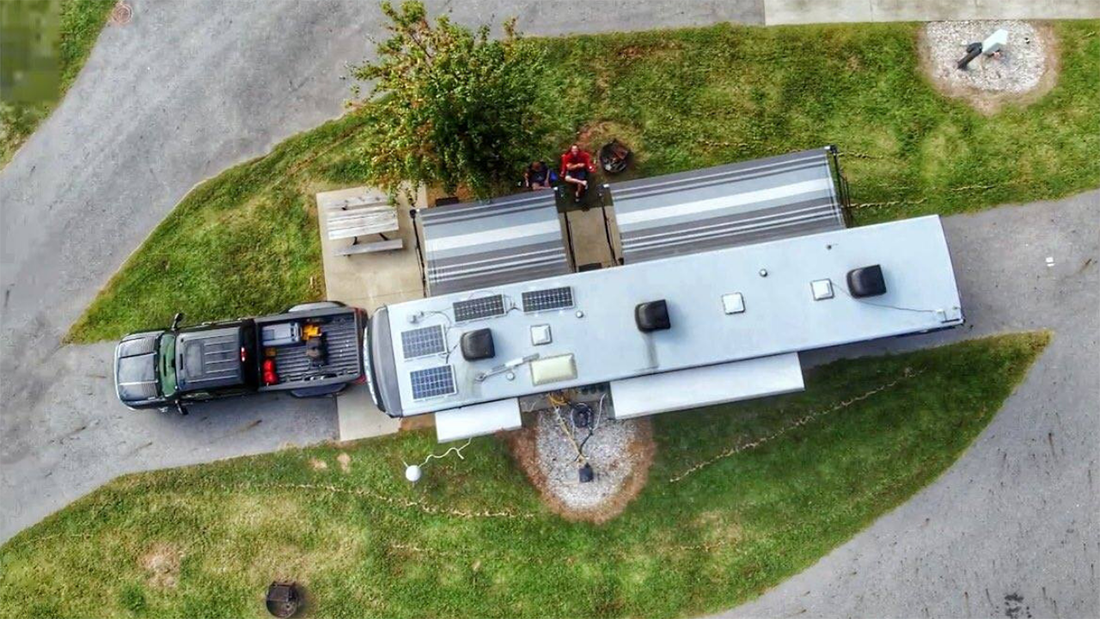Hi Mark My Words readers! We’re dealing with lots of leaks this month as well as a screen door question. Have you inspected your roof lately? Remember to send your RVing questions to [email protected]. Use these tips as you return to the driver seat this summer.
Hi Mark,
I have some leakage from seams on top of my Sprinter van converted to motor home by Great West. Best way to find leaks and caulk them.
Sincerely,
Sidney
Hi Sidney,
The best way to find most roof leaks is to do a really thorough visual inspection of the entire roof, looking for any seams that aren’t sealed properly, and for any cracks or holes in the roof and the vents and skylights. If you find anything that looks questionable, purchase a self-levelling roof caulk designed for RV roofs. Make sure the caulk is compatible with your roof material: there are special formulas for rubber roofs, and for metal and fiberglass roofs. Clean the area to be caulked thoroughly and remove any loose or deteriorated old caulk. Using a caulking gun, lay a heavy bead along the seam. The caulk should flow and flatten out, making a good seal. There should be an intact layer of caulk around anything that protrudes through the roof, that includes roof and plumbing vents, rails and ladder attachments, and around the refrigerator vent. It’s a good idea to inspect your roof annually, looking for any spots that may need repair or re-caulking. If re-caulking the seams doesn’t stop the leak, you may need to take the RV to a service facility that can use a large fan to pressurize the RV interior, and then spray the RV with a soapy solution. This will usually find any leaks that are hidden, as air escaping from the leak will cause bubbles in the soap solution on the RV.
Mark:
We own a 39 ft. Open Range 5th wheel. It has the full glass view door. Therefore, it does not have a screen door. Have you heard of anyone installing a roll away or any type of screen door? I really like this door as gives light, but I would like to be able to open the door to let some air flow.
Thanks,
Gayle
Hi Gayle,
Have you ever seen these screens? They are magnetic, so they attach easily, and roll up for storage when you don’t need them. Check out this Magnetic Screen Door and Magic Mesh Instant Magnetic Screen Door.
Might be just what you need!
Hi Mark,
Last summer we had a leak in our 2011 Coachmen in the front of our class C in the nose of the bunk. We fixed it and we’re now just wondering what kind of insulation to put back up there or is there something else to use. Looking forward to hearing from you.
Thanks,
Christine
Hi Christine,
That’s a pretty common problem with class-Cs, glad to hear you’ve got the leak stopped. My C had serious water leaks in the cabover before I got it, and the only thing that saved it was the fact that Fleetwood used Styrofoam for insulation, rather than the fiberglass batts. Styrofoam won’t absorb water, so I didn’t have lots of wood rot in the leak areas. For that reason, I’d suggest that you use Styrofoam or closed cell foam insulating sheets when you repair it. You can get foil-faced foam insulating sheets at Lowes or Home Depot, and it’s easy to cut with a utility knife. That’s the way I’d go!

Hi Mark,
I have soft spots on my rubber roof near my air conditioner. I’m being told that the entire roof needs to be pulled back to determine why the soft spots are there (very costly). There is NO leaking inside my trailer, and nothing on the roof to indicate water is getting in between rubber and Luann sheeting. I had a Mobile RV Service tech analyze my situation who is puzzled. He removed the air conditioning vent from inside the trailer and could not see anything up inside to indicate a leak so he couldn’t advise whether the condition would worsen. Can Eternabond be used around all my seams, skylights, vents etc. to prevent any further water from reaching these soft spots? Do you have any other suggestions? Or is my only alternative to have the entire roof peeled back to diagnose and repair.
Joyce
Hi Joyce,
Roof leaks in RVs are unfortunately fairly common. After all, an RV moves and flexes a lot, and all seams and sealers are subjected to a lot of stress. The hardest part is finding the source of the leak. Water can travel a long way from the point of entry and pool in a low spot or saturate part of the structure of the RV without ever appearing as a visible leak in the interior. If the roof around the A/C unit is soft, I’m inclined to suspect the worst: that there is a long-standing small leak up there somewhere that has saturated part of the roof structure and caused the wood to rot. You didn’t mention the age of the unit, but such problems generally take a year or two to develop. Once the wood is rotted, preventing new water from reaching it doesn’t solve the problem. It should not be necessary to peel large sections of the roof initially to investigate. I’d start by completely removing the A/C unit from the roof vent and inspecting the surrounding area and the gasket under the unit. If water has been coming in there, it should be fairly obvious. A close inspection of all sealants and seams on the whole roof should also be done, looking for any obvious cracks or holes. Inside, if there are light fixtures or vents in the ceiling near the soft area, remove some of the screws that secure them to the ceiling. If the screws are rusty, it proves there is water up there. If any signs of water entry are found, the next step will unfortunately be to peel part of the roofing to expose the damaged area and repair it. If you cannot find any signs of water entry at all, then monitor the extent of the soft area for a while and see if it gets any worse, or seems to be spreading. If it doesn’t, it may not be an ongoing problem, or may be caused by something other than a water leak.
Mark:
We have a 5th-wheel Komfort RV. We recently went on a weekend trip and noticed a slight but constant dripping of water when the hose line was hooked up to the intake. The leak came from the rear right corner of the RV. The water intake is located in the rear middle of the RV. When we returned home, I checked the problem and it occurred again. I attached a pressure control valve and limited the pressure to 40 lbs. It still had a slight leak. Do you have any suggestions as to where it might be leaking and how I might fix the leak?
Thanks
Ruben
Hi, Ruben:
Based on your description of the problem, I suspect that you are looking at a leak in the fresh-water supply plumbing. The first thing I would do is disconnect the hose from the city water inlet. Then, I’d put some water in the fresh water tank, turn on the RV’s 12V water pump and open every faucet long enough to purge out any air in the system. Make sure all faucets are closed, then see if the pump continues to cycle on and off with no faucet open. The pump works on a pressure switch, so if the pump does run or cycle, you have a leak somewhere in the fresh-water supply plumbing. That means it’s time to get out your flashlight and visually inspect all of the plumbing lines that you can see or can gain access to. You may need to look inside cabinets and compartments to find the actual leak.
However, if the pump does not cycle at all, then it is fairly safe to assume that the fresh-water supply plumbing is intact. That said, you should start looking for other possible sources for the water. The water you see dripping could be coming from the sink or tub drain plumbing, your holding tanks, the fresh water tank, or could even be caused by a small leak right at the city water connection that is running aft to the rear of the trailer before dripping. Once you find the leak, most RV plumbing can be repaired using standard plumbing parts available from any home improvement store.




